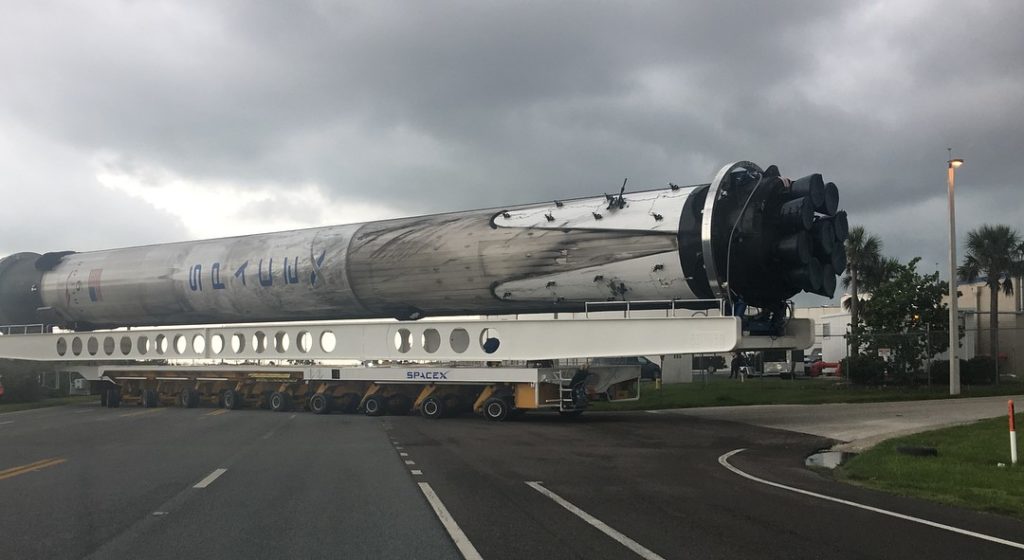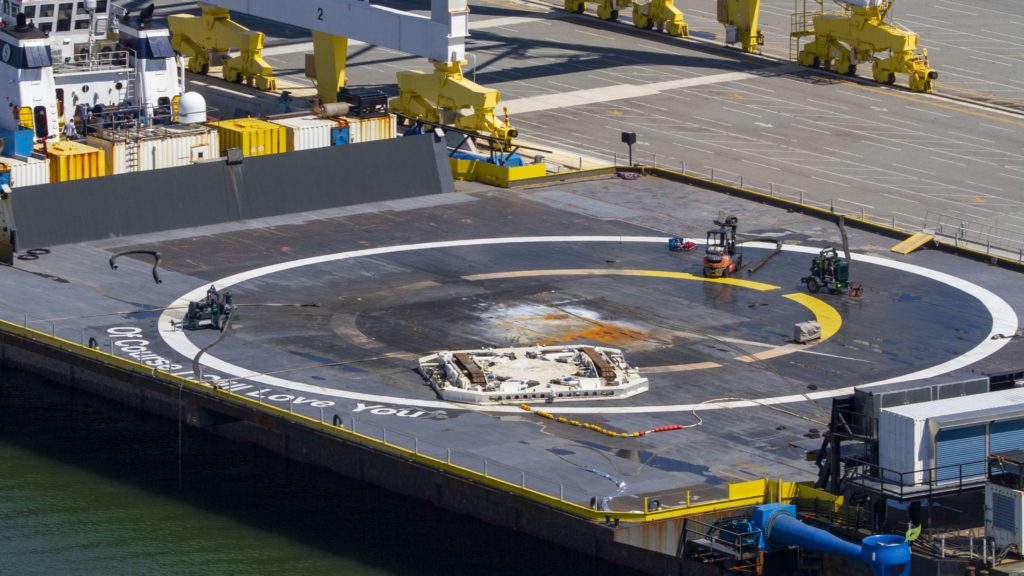

News
SpaceX’s Falcon 9 Block 5 rocket looks no worse for wear after dual launches
SpaceX’s first Falcon 9 Block 5 booster has returned to Port Canaveral, FL once again after the rocket’s second successful launch, likely the first of countless reuses to come over the next months and years. Of note, B1046.2 (Booster 1046, flight 2) was by all appearances in as good of condition as it was when it lifted off from Pad 40 just three days prior.
While it may be difficult to immediately distinguish between B1046’s second launch and recovery and those of previous, older Falcon 9 boosters, Block 5 is a quite simply an entirely different story. Moreover, the fact that SpaceX went from the major upgrade’s launch debut to first booster reflight in barely three months is an extraordinarily good indication that Block 5’s first flightworthy design (especially the parts not visible to the public) is very close to its engineers’ theoretical intentions.
Some additional shots of today's B1046.2 return to port. @SpaceX @SpaceXUpdates @elonmusk @SpaceXFleet #SpaceX pic.twitter.com/d4ivQ8PRuU
— The Aerospace Geek (@ThAerospaceGeek) August 10, 2018
Falcon 9 B1046’s second recovery also happened to be the quickest yet for SpaceX by a healthy margin, taking just 4.5 days to travel 400 miles back to port, be lifted off drone ship Of Course I Still Love You, have its legs removed, and be loaded horizontally onto SpaceX’s dedicated Cape Canaveral booster transporter. Whether or not the rocket itself is ready for another flight with absolutely zero refurbishing in between, this demonstration of just how quickly SpaceX’s infrastructure can operate indicates that much of the framework needed for truly rapid reuse is already largely in place.
Once SpaceX is confident that Block 5 can be reflown with little more than new fuel added and has lined up multiple payloads for launch in just a few days or weeks, it’s clear that the company will already have the ability to launch (and reuse rockets) so quickly that drone ship availability will become the primary bottleneck. For example, if B1046 could have shipped to one of SpaceX’s launch sites moments after it was loaded on its transporter and prepped for the second launch within 24-48 hours of going horizontal, it’s extremely unlikely that OCISLY could be readied for another booster recovery and towed several hundred miles off the coast in time to catch B1046 after its third launch.
- B1046 returned to Port Canaveral shortly after its May 4 debut, and is now being carefully analyzed as pathfinder hardware. (Tom Cross)
- Soon after, B1046 was spotted on its way to a refurbishment facility around a week after its May 11 launch debut. (Instagram /u/tersco)
- It’s currently unclear whether B1046 or B1048 will become the first SpaceX rocket to fly three times. (Tom Cross)
- 60 hours after docking, B1046 was loaded horizontally onto its transporter. (Tom Cross)
- SpaceX’s rocket-securing robot, known as Octagrabber, seen on OCISLY after another successful rocket recovery, August 12th. (Tom Cross)
As such, barring the extremely rapid completion of SpaceX’s third drone ship (named A Shortfall of Gravitas), it can be all but guaranteed that SpaceX will need to use its land-based Landing Zone 1 to accomplish CEO Elon Musk’s challenge of launching, landing, and relaunching the same Falcon 9 booster in less than 24 hours sometime before the end of 2019. Even then, it seems likely that SpaceX would either need to dramatically improve the turnaround capabilities of one of its launch sites or conduct those back-to-back launches using both of the company’s two Florida pads (LC-39A and LC-40).
Regardless, the first reuse of a Falcon 9 Block 5 booster unequivocally marks the beginning of a new era for SpaceX and for orbital rocketry worldwide. According to one of SpaceX’s webcast hosts during the second flight of B1046 (for the launch of Telkom 4/Merah Putih), the rocket’s third launch (a first for SpaceX) is already in planning for an unspecified mission later this year. As SpaceX rockets begin to rack up 3, 5, 10, or more launches apiece and the act of reusing Falcon 9s becomes so routine that it bores all but the most ardent followers, you’ll know that SpaceX has essentially succeeded in the first step of its master plan. Next stop: BFR and Mars.
For prompt updates, on-the-ground perspectives, and unique glimpses of SpaceX’s rocket recovery fleet (including fairing catcher Mr Steven) check out our brand new LaunchPad and LandingZone newsletters!
News
Tesla begins Robotaxi certification push in Arizona: report
Tesla seems serious about expanding its Robotaxi service to several states in the coming months.

Tesla has initiated discussions with Arizona transportation regulators to certify its driverless Robotaxi service in the state, as per a recent report from Bloomberg News. The move follows Tesla’s launch of its Robotaxi pilot program in Austin, Texas, as well as CEO Elon Musk’s recent comments about the service’s expansion in the Bay Area.
The Arizona Department of Transportation confirmed to Bloomberg that Tesla has reached out to begin the certification process for autonomous ride-sharing operations in the state. While details remain limited, the outreach suggests that Tesla is serious about expanding its driverless Robotaxi service to several territories in the coming months.
The Arizona development comes as Tesla prepares to expand its service area in Austin this weekend, as per CEO Elon Musk in a post on X. Musk also stated that Tesla is targeting the San Francisco Bay Area as its next major market, with a potential launch “in a month or two,” pending regulatory approvals.
Tesla first launched its autonomous ride-hailing program on June 22 in Austin with a small fleet of Model Y vehicles, accompanied by a Tesla employee in the passenger seat to monitor safety. While still classified as a test, Musk has said the program will expand to about 1,000 vehicles in the coming months. Tesla will later upgrade its Robotaxi fleet with the Cyercab, a two-seater that is designed without a steering wheel.
Sightings of Cybercab castings around the Giga Texas complex suggests that Tesla may be ramping the initial trial production of the self-driving two-seater. Tesla, for its part, has noted in the past that volume production of the Cybercab is expected to start sometime next year.
In California, Tesla has already applied for a transportation charter-party carrier permit from the state’s Public Utilities Commission. The company is reportedly taking a phased approach to operating in California, with the Robotaxi service starting with pre-arranged rides for employees in vehicles with safety drivers.
News
Tesla sets November 6 date for 2025 Annual Shareholder Meeting
The automaker announced the date on Thursday in a Form 8-K.

Tesla has scheduled its 2025 annual shareholder meeting for November 6, addressing investor concerns that the company was nearing a legal deadline to hold the event.
The automaker announced the date on Thursday in a Form 8-K submitted to the United States Securities and Exchange Commission (SEC). The company also listed a new proposal submission deadline of July 31 for items to be included in the proxy statement.
Tesla’s announcement followed calls from a group of 27 shareholders, including the leaders of large public pension funds, which urged Tesla’s board to formally set the meeting date, as noted in a report from The Wall Street Journal.
The group noted that under Texas law, where Tesla is now incorporated, companies must hold annual meetings within 13 months of the last one if requested by shareholders. Tesla’s previous annual shareholder meeting was held on June 13, 2024, which placed the July 13 deadline in focus.
Tesla originally stated in its 2024 annual report that it would file its proxy statement by the end of April. However, an amended filing on April 30 indicated that the Board of Directors had not yet finalized a meeting date, at least at the time.
The April filing also confirmed that Tesla’s board had formed a special committee to evaluate certain matters related to CEO Elon Musk’s compensation plan. Musk’s CEO performance award remains at the center of a lengthy legal dispute in Delaware, Tesla’s former state of incorporation.
Due to the aftermath of Musk’s legal dispute about his compensation plan in Delaware, he has not been paid for his work at Tesla for several years. Musk, for his part, has noted that he is more concerned about his voting stake in Tesla than his actual salary.
At last year’s annual meeting, TSLA shareholders voted to reapprove Elon Musk’s compensation plan and ratified Tesla’s decision to relocate its legal domicile from Delaware to Texas.
Elon Musk
Grok coming to Tesla vehicles next week “at the latest:” Elon Musk
Grok’s rollout to Tesla vehicles is expected to begin next week at the latest.

Elon Musk announced on Thursday that Grok, the large language model developed by his startup xAI, will soon be available in Tesla vehicles. Grok’s rollout to Tesla vehicles is expected to begin next week at the latest, further deepening the ties between the two Elon Musk-led companies.
Tesla–xAI synergy
Musk confirmed the news on X shortly after livestreaming the release of Grok 4, xAI’s latest large language model. “Grok is coming to Tesla vehicles very soon. Next week at the latest,” Musk wrote in a post on social media platform X.
During the livestream, Musk and several members of the xAI team highlighted several upgrades to Grok 4’s voice capabilities and performance metrics, positioning the LLM as competitive with top-tier models from OpenAI and Google.
The in-vehicle integration of Grok marks a new chapter in Tesla’s AI development. While Tesla has long relied on in-house systems for autonomous driving and energy optimization, Grok’s integration would introduce conversational AI directly into its vehicles’ user experience. This integration could potentially improve customer interaction inside Tesla vehicles.
xAI and Tesla’s collaborative footprint
Grok’s upcoming rollout to Tesla vehicles adds to a growing business relationship between Tesla and xAI. Earlier this year, Tesla disclosed that it generated $198.3 million in revenue from commercial, consulting, and support agreements with xAI, as noted in a report from Bloomberg News. A large portion of that amount, however, came from the sale of Megapack energy storage systems to the artificial intelligence startup.
In July 2023, Musk polled X users about whether Tesla should invest $5 billion in xAI. While no formal investment has been made so far, 68% of poll participants voted yes, and Musk has since stated that the idea would be discussed with Tesla’s board.
-

 Elon Musk1 week ago
Elon Musk1 week agoTesla investors will be shocked by Jim Cramer’s latest assessment
-

 Elon Musk3 days ago
Elon Musk3 days agoElon Musk confirms Grok 4 launch on July 9 with livestream event
-

 Elon Musk14 hours ago
Elon Musk14 hours agoxAI launches Grok 4 with new $300/month SuperGrok Heavy subscription
-

 News7 days ago
News7 days agoTesla Model 3 ranks as the safest new car in Europe for 2025, per Euro NCAP tests
-

 Elon Musk2 weeks ago
Elon Musk2 weeks agoA Tesla just delivered itself to a customer autonomously, Elon Musk confirms
-

 Elon Musk1 week ago
Elon Musk1 week agoxAI’s Memphis data center receives air permit despite community criticism
-

 Elon Musk2 weeks ago
Elon Musk2 weeks agoTesla’s Omead Afshar, known as Elon Musk’s right-hand man, leaves company: reports
-

 News2 weeks ago
News2 weeks agoXiaomi CEO congratulates Tesla on first FSD delivery: “We have to continue learning!”
























